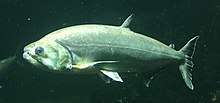Hydrolycus
Hydrolycus is a genus of large dogtooth characins from tropical South America, where found in the Amazon and Orinoco basins, as well as rivers of the Guianas.[1] The genus includes the largest dogtooth characins, reaching up to 1.17 m (3.8 ft) in length.[1] They have long, pointed teeth (shorter and less extreme in H. wallacei) used for spearing their prey, generally smaller fish.[2] In a study of the stomachs of 45 individuals, most were empty, but among the remaining the prey fish were 15–50% of the length Hydrolycus itself.[3]
| Hydrolycus | |
|---|---|
 | |
| Hydrolycus scomberoides | |
| Scientific classification | |
| Kingdom: | |
| Phylum: | |
| Class: | |
| Order: | |
| Family: | |
| Genus: | Hydrolycus (J. P. Müller & Troschel, 1844) |
In 1999 two new species were described, the first in this genus in 158 years.[1][2]
Species
There are currently four described species.[1]
- Hydrolycus armatus (Jardine, 1841) (Payara)
- Hydrolycus scomberoides (G. Cuvier, 1819) (Payara)
- Hydrolycus tatauaia Toledo-Piza, Menezes & dos Santos, 1999
- Hydrolycus wallacei Toledo-Piza, Menezes & dos Santos, 1999
gollark: I said I would have it done within two days. I picked one yesterday but have been writing the test suite. It will be released at 18:00.
gollark: I should write my test suite for the codegueß challenge so ubq can releaseize it.
gollark: Yes, loops as expressions is cool.
gollark: Seems fine.
gollark: Exciting*!
References
- Froese, Rainer and Pauly, Daniel, eds. (2017). Species of Hydrolycus in FishBase. January 2017 version.
- Toledo-Piza, M.; N.A. Menezes; and G.M. Santos (1999). "Revision of the Neotropical fish genus Hydrolycus (Ostariophysi: Characiformes: Cynodontidae) with the description of two new species". Ichthyol. Explor. Freshwaters. 10 (3): 255–280.CS1 maint: uses authors parameter (link)
- Goulding, M (1980). The Fishes and the Forest: Explorations in Amazonian Natural History. University of California Press. pp. 185–186. ISBN 0-520-04131-3.
This article is issued from Wikipedia. The text is licensed under Creative Commons - Attribution - Sharealike. Additional terms may apply for the media files.
